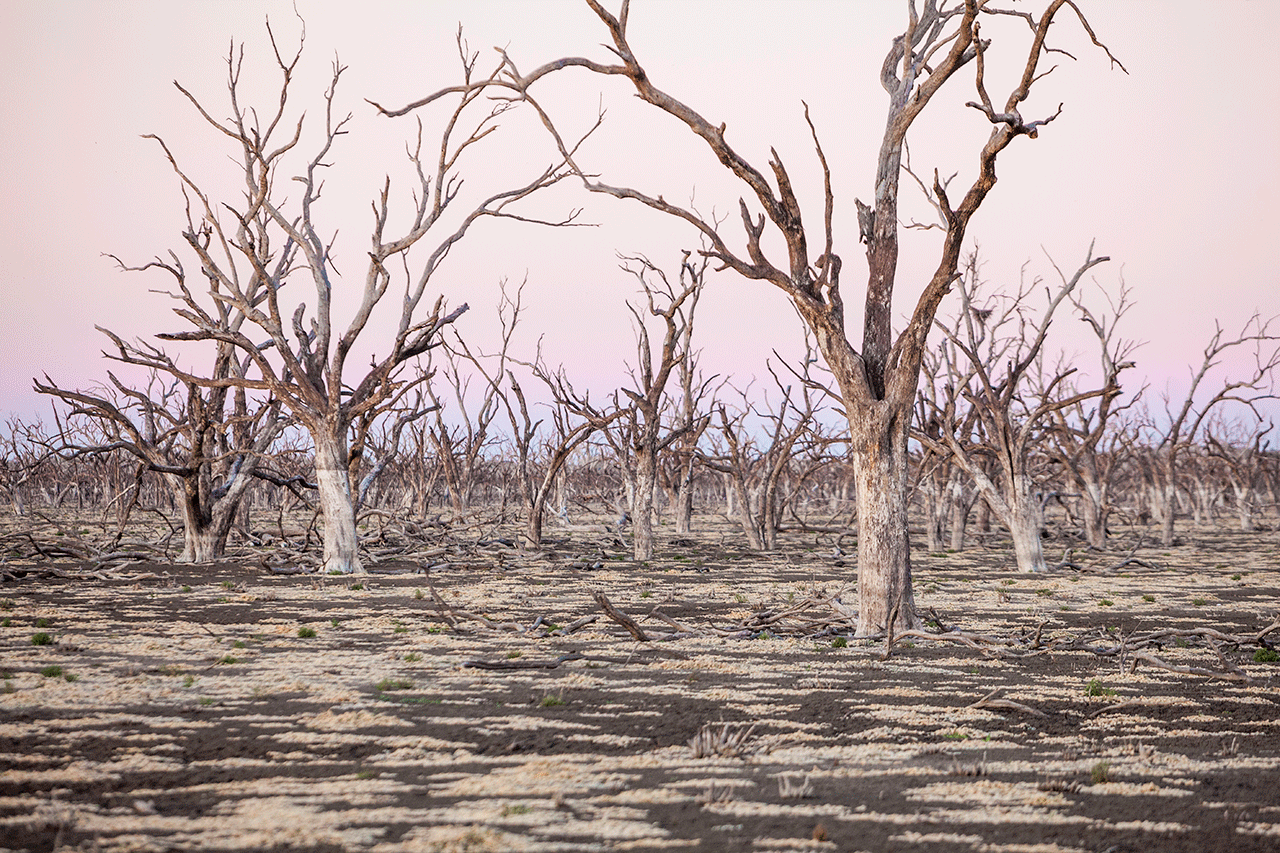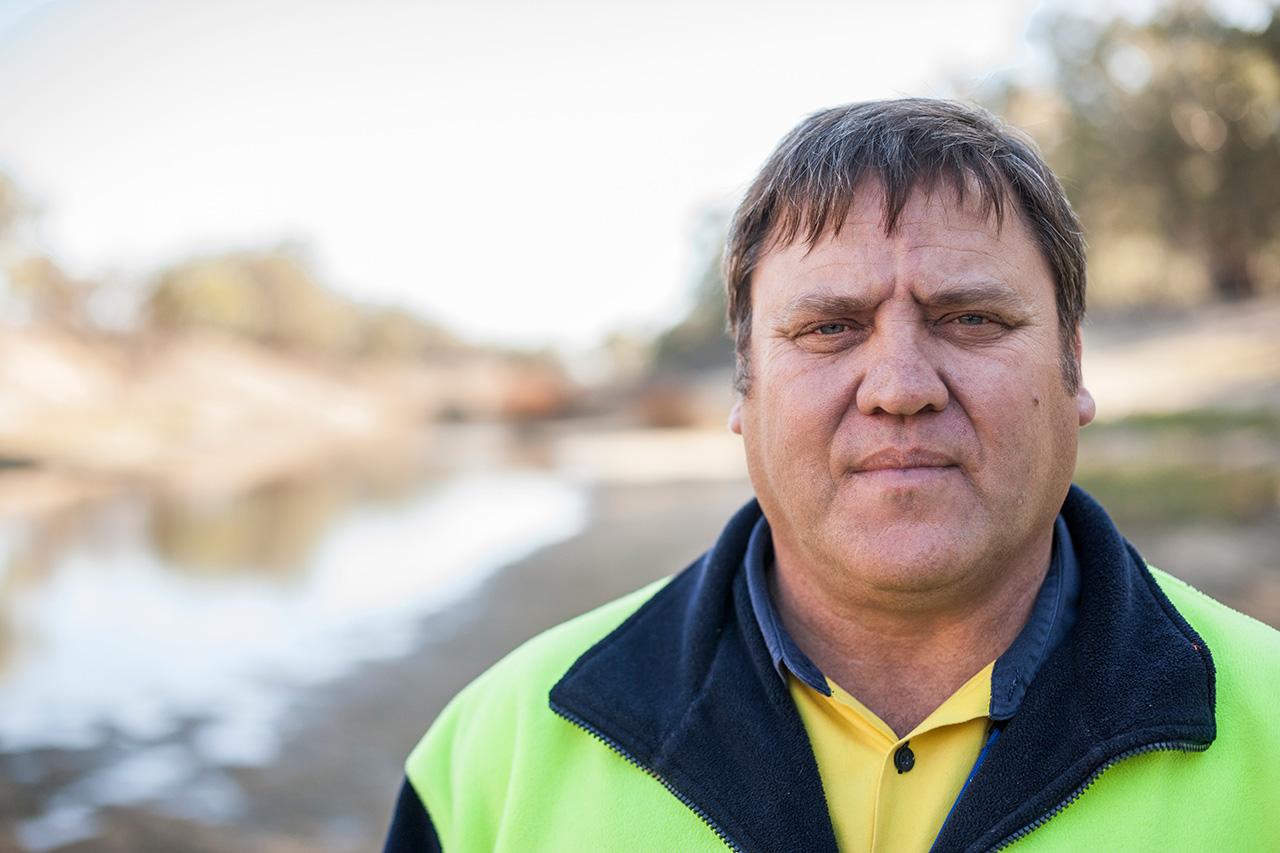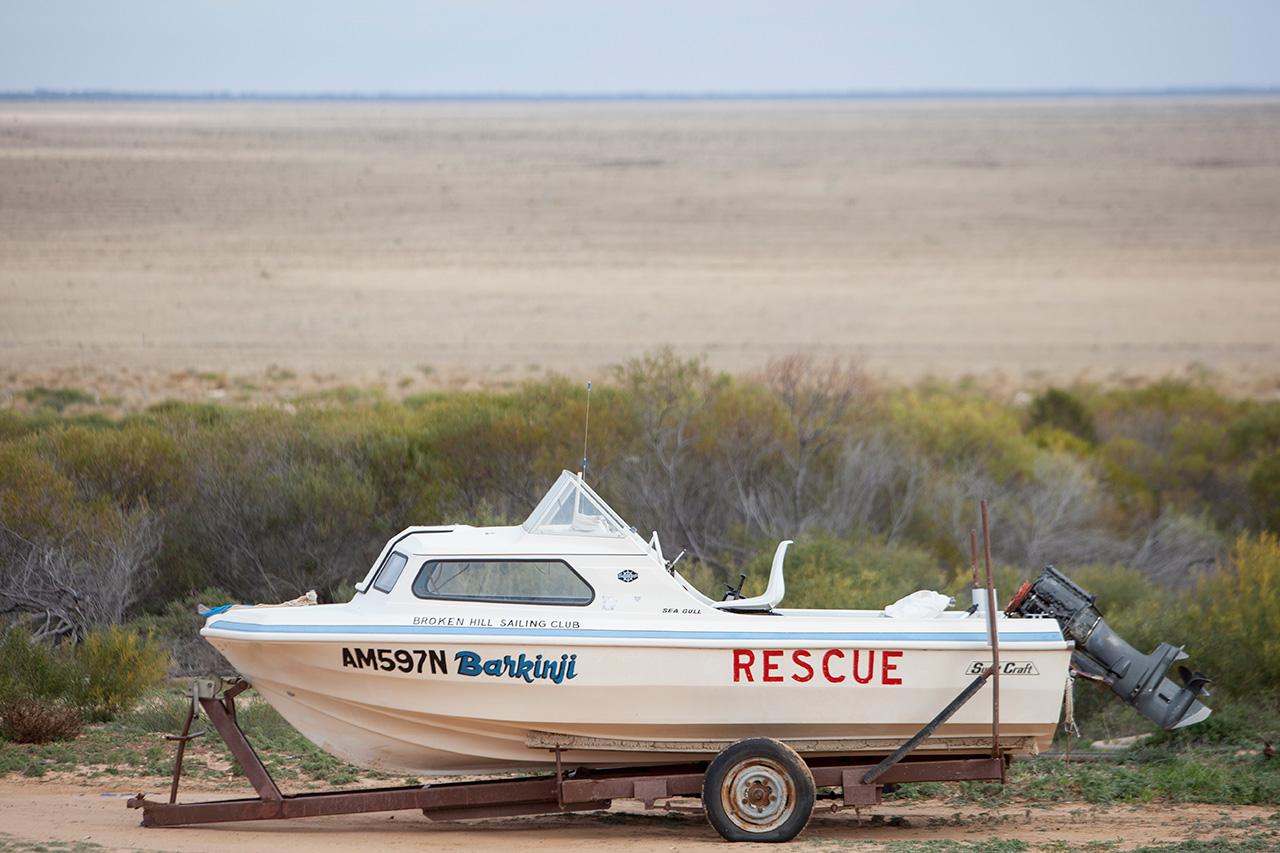“If the Lord won’t send us water, oh, we’ll get it from the devil.”
—Banjo Paterson, “Song of the Artesian Water” (1896)
It’s April in the outback of New South Wales, a southeastern state of Australia, and the afternoon sun is warming the red, sandy, and scrubby plains. We’re near the desolate area where The Road Warrior was filmed. But the movie got it wrong. The real fight around here is not for oil. It’s for water.
“You’re under five meters of water right now,” Barry Philp says. “Hard to imagine, isn’t it?” I look through the windshield of his pickup. The sky is blue and empty and the land is dead flat.
We’re rattling along the gray clay bottom of Lake Menindee, several miles from its shore. Three years ago the lake was full. Together with surrounding lakes, it held five times the water in Sydney Harbor. Rainfall in the past three years is tracking lower than the worst on record. The lakebed is now bone dry.
Philp, a solid man in his late 40s, manages the Menindee Lakes system. The system was built in the 1950s to secure a water supply for the mining town of Broken Hill, 70 miles northwest. It diverts water from the nearby Darling River, storing it in plains and lakes that previously filled only in floods. For the second time this century, it’s on the point of failure.
This past December, government officials estimated Broken Hill, population 18,000, would run out of water in August. Amid news about coming droughts around the world, and record temperatures forecast to get even hotter, I’ve come to an iconic Australian town to see how it’s reached the brink of running dry.
The struggle for water draws out the character of the continent and the dreams woven deep into the psyche of the people who settled here. “We have a major problem,” says John Williams, former chief of the land and water division of Australia’s national science agency. “It’s a clash between what the land can do and how it works, and our aspirations for a stationary, Western civilization.”
Residents are prohibited from watering their gardens during the day. They must wash their cars and paving with buckets, not hoses.
Philp pulls up to a blue rig rising above the plain, surrounded by trucks and men. He grew up nearby, in the hamlet of Menindee, where his mum, Beryl, was born on the Menindee Aboriginal Station. As a local resident who also works for State Water, Philp is stuck between a desert and a dry place. He’s welcoming but reserved, as if he’s decided fewer words will upset fewer people. He must implement unpopular water-policy decisions made elsewhere by the New South Wales government. We’re visiting the latest controversy: a bore-drilling program searching for underground supplies.
We look on as water gushes from a bore, muddy at first, then clearer. Nick, a geo-hydrologist from Canada, takes samples. It had taken less than a day to bore a hole—about 55 meters deep—and prepare the site to pump water up through a narrow pipe from the aquifer. The scientists will pump the water nonstop for two days, evaluating its flow rate and quality.
While the drillers are working around the clock, the residents of Broken Hill are agitating for them to stop. They’re worried about contaminants in bore water and believe drilling for groundwater is a government plot to decommission the lakes altogether. “We’ve been fighting the New South Wales government for 200 years,” says Mark Hutton, a retrenched miner and longtime water activist, one of the leaders of a grassroots group called WE WANT ACTION.
Chemists define it as H2O, but to understand water as a substance that brings hope and despair, you need a more complex formula. In Broken Hill, add salt and scarcity, erosion and evaporation, intractable politics and intergenerational memory, speedboats and roses. Stir and stand back because the state government is about to announce an emergency water plan for the town.
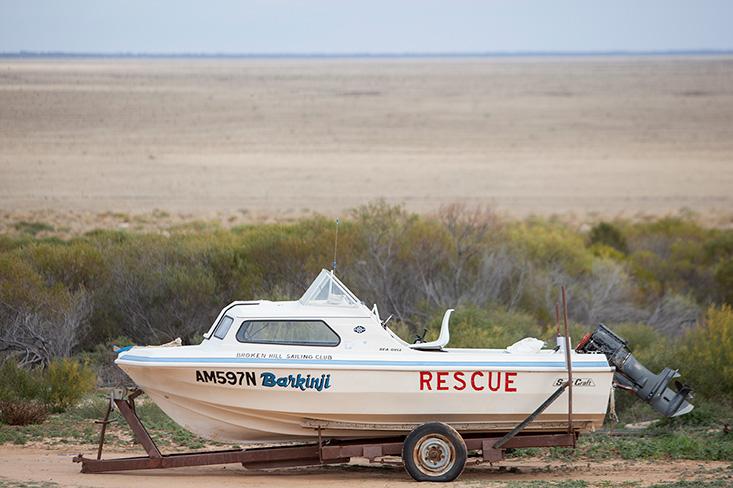
I walk into the center of Broken Hill to meet Mayor Wincen Cuy, also a hotelier and tourism operator. Today, an unusual cold snap has filled its famous wide-angle blue sky with gray clouds. It feels a century apart from other Australian towns. Instead of the typical big-box stores and cement-sheet houses, its broad, empty streets are lined with old-time architecture: solid miners’ cottages, some with corrugated iron roofs and fences, whose owners keep their yards bare and shutters drawn; small brick warehouses; and, on the corners, thick-walled hotels with faded Victorian splendor, where workers once slaked their underground thirsts.
The town was named after a diary note by Captain Charles Sturt, a 19th-century English explorer, obsessed with discovering an inland sea on the Australian continent. One exhausted day, resting on a craggy black outcrop, which Aboriginal people called Willyama, he jotted “Broken Hill” in his journal. Four decades later, the hill would be pegged for a mine. It would become the world’s largest silver, lead, and zinc mining field. Broken Hill is also known as Silver City.
Today, though, the hill has been truly broken—dug over three times. Now known variously as the line of lode, the mullock heap, the skimp dump, or the slag heap, the hill remains the town’s defining, if surreal, geographical feature. It runs parallel to the main street, 50 meters high, separating the north and south suburbs. A restaurant and a memorial to the miners who died on the job sit on top of the heap. But the restaurant has shut down, and all the road signs to the lookout have been removed. Both buildings have outlines like ships, and there they sit, marooned and precarious, as if waiting for the Flood.
“Water is a major concern for us,” says Cuy, who owns the lease on the shuttered restaurant. “We owe it to the citizens of Broken Hill to explore every possibility, whether it’s palatable or not.”
Cuy and I are sitting outdoors at a diner in the town’s wide main street. It’s a casual place but Cuy wears a gray suit. Two days earlier, Cuy had tangled with the activists, after interrupting their meeting with the visiting state water minister. “For the sake of the community, I wasn’t prepared to let the minister get railroaded,” he says. “They have a point of view that we shouldn’t have bore water,” as it can indeed contain harmful microorganisms. “Do I want bore water? No. Do I prefer bore water over no water? Absolutely!”
Cuy speaks with conviction, but looks deeply tired, glancing sidelong while he speaks, monitoring the passers-by. His great-great-grandfather lived here when the town was founded. He knows its volatile history. As a 1968 chronicle of the local water board, Water Carts to Pipelines, by historian Bobbie Hardy, put it, “The ancient dry wrinkles of the Barrier Ranges were never meant to foster a city. From the beginning, the greatest problem of the isolated settlement was water, and water it has remained.”
The first water protests were held less than four years after the ore body was discovered in 1883. Then, in 1888, nearly three-quarters of the population—12,000 residents—gathered in front of the town’s Grand Hotel, protesting the decision by the mining minister, Francis Abigail, not to permit water to be railed in from a nearby source. The next night, protesters made an effigy of the minister, drew it on a hearse to a gallows and proceeded to hang and burn it. “It was,” reported the local newspaper, Silver Age, “the most brilliant appearance that the Hon. Francis Abigail is ever likely to make in Broken Hill.”
Emergency water supplies were carted in by train that year, and again for long periods in the 1890s, the 1900s, and the 1940s. And now the town is on the edge of emergency again.
In December, water restrictions were introduced, prohibiting residents from watering their gardens during the day and filling empty swimming pools. They must wash their cars and paving with buckets, not hoses. The town’s consumption fell by a fifth from the previous year. Still, for Cuy, maintaining the town’s greenery is a matter of honor. “Have you seen Sturt Park?” he asks, pointing to an undulating expanse of lush green grass. “It’s our pride and joy. In the semi-arid environment we live in, it’s a great spectacle.”
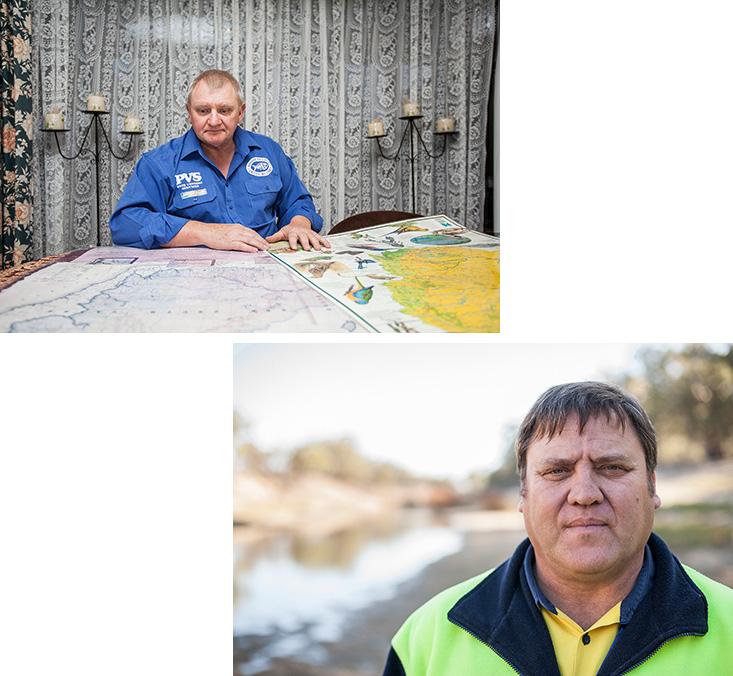
Australia is a land of extremes. It is the driest inhabited continent on Earth, susceptible to floods, which inhabitants expect someday will come. But they won’t reach Broken Hill.
The town stands at the far western edge of the Darling River’s catchment. The river is long and meandering; many of its tributaries run dry, others connect with it only rarely. The bottom line: If you need water, don’t depend on the Darling. The same year Broken Hill was founded in 1883, a paddle-steamer named Jane Eliza set off from the town of Morgan, downstream, to navigate the river. It took three years to reach Bourke, a town only 700 miles north as the crow flies.
Most rivers have a variation of fivefold or less between their peak and low flows. During wet years on the Darling, however, monsoon rains in its far northeast bring volumes 15 to 20 times its minimum, making it among the most variable in the world.
Together with the Murray River, farther south, it comprises the Murray Darling Basin, a vast, largely flat catchment covering one-seventh of the continent. The basin spans the territory of 30 Aboriginal language groups, and now it is home to 2 million people, who produce a large proportion of the nation’s cereals, oranges, apples, grapes, pigs, sheep, cattle and dairy, and nearly all of its cotton.
The region’s geology is ancient. Highlands lifted to the east 60 to 32 million years ago; while to the west, the basin subsided over a shallow saucer of 350-million-year-old rock. Over millions of years, the seas advanced and retreated, depositing salt and sand and forming river plains, as the climate oscillated between very humid and very arid. In the present climate, rainfall outpaces evaporation only in the eastern margins. From there, the waters move slowly west and south through semi-arid and arid plains.
In modern Australia, the Murray Darling Basin has been overlaid with a diabolical political geography: It traverses one national government, four states, and 98 local councils.
“Like the lotus-eaters, we inhabit a dream world where water is plentiful and the landscape resembles the soft, green hills of Europe. It is time to awake and accept where we live.”
In November 1991, a regional water office issued a warning: Landholders should not drink from the Darling River and should keep livestock clear of its banks. By December, the beginning of summertime, a spectacular, toxic bloom of blue-green algae had spread more than 600 miles along the river. Breeding in stagnant waters and fed by fertilizer and livestock manure runoff, it formed the world’s largest recorded algal bloom. The New South Wales government declared a state of emergency.
At the time, Williams was in a senior role at Australia’s national science and research organization, in charge of researchers working to solve the crisis. “The water storages off the Darling were green, just green from side to side,” he says. “These were our water supplies—it was a frightening, panicky thing. It woke us up to the fact that we’d taken too much out of the river.”
The second half of the 20th century was wetter than the first half and irrigation boomed. The capacity of dams in the Murray Darling Basin grew sixfold and by the 1990s the volume of water being taken from the river was approaching the system’s average natural flow to the sea. All this irrigation, along with the clearing of woodlands and forests, caused salty water tables to rise and discharge to the rivers. But with fewer floods reaching the river mouth, the salt stays on the land.
The algal blooms shocked policymakers into capping diversions from the catchment, but the freeze applied only to surface water. Afterward, groundwater extraction surged.
The big Australian cities cling to the coastline. Situated on rivers, they are supplied by large dams in their immediate water catchment. But inland, where surface water is scarce, miners and farmers—and increasingly, householders—look underground. In New South Wales about four in 10 rural towns rely on bores, partly or wholly, for their potable water.
Most groundwater in Australia comes from rainfall. Flood water seeps into the land, filtering down until it becomes trapped and stored in porous soils and rocks. Likewise, during dry times, shallow groundwater feeds the flow of the rivers. Over time, fewer floods will mean less groundwater, and less river flow.
Williams, the son of generations of farmer-settlers, has been on the frontlines of Australia’s water battles for decades. To him, water problems run deeper than the elements. In 2003 he wrote an article in Australasian Science magazine called “Can we myth-proof Australia?” He argued that the national psyche is “dominated by dreams of water.”
“It isn’t the drought that is the problem,” he wrote. “It is our delusions. Like the lotus-eaters, we inhabit a dream world where water is plentiful and the landscape resembles the soft, green hills of Europe. It is time to awake and accept where we live.”
Ever since British colonization, Williams says, Australians have failed to learn about the landscape and live within its means. When the “First Fleet” of officers and convicts arrived in Sydney Cove in 1788, they established camp by the “Tank Stream.” During an early drought, tanks were constructed along its banks. Before long, the stream was a watering hole for livestock, a sewer, and a drain for industrial waste. It was undrinkable. Its source, a nearby marsh, was used up and drained, as was the settlement’s subsequent water source, the Lachlan Swamps.
The Tank Stream is “a classic case” of the Australian approach to water, Williams says. “We polluted it within 12 months of getting there. Yet Aboriginal people had been managing it for 50,000 years.”
By the beginning of the 20th century, the settler society’s water dreams became known as “Australia Unlimited,” after a 1,000-page patriotic book written by journalist Edwin Brady. The dreamers proposed outlandish schemes, from channeling the sea inland and turning tropical rivers south, to mining immense volumes of groundwater. You can still hear some of them today.
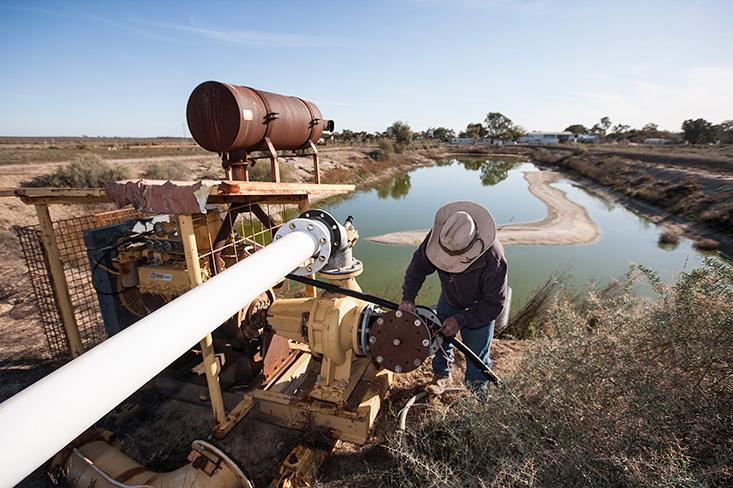
But Australia is limited. From 1995 to 2009, Australia experienced the “millennium drought,” which ranked among the worst dry spells since the British colony began. In 2002, as the drought dragged on, Williams and other scientists gathered for dinner at Sydney’s Wentworth Hotel. All of them were worried about patterns of land use and abuse, the depletion of water and soils, and the consequences for farmers. After the meal, they formed the Wentworth Group of Concerned Scientists, an unpaid, independent expert group determined to influence the media and public policy.
In 2012, a bruising, years-long political process culminated in the federal government’s “Basin Plan,” a blueprint, supposedly, for the rivers’ sustainable management. The Wentworth Group scientists damned it: The plan still allowed a volume of water to be diverted from the river that would rival its total flow.
To make matters worse, the modeling assumed climate change wouldn’t pose a risk to river health, even though projections suggest significant reductions in rainfall and runoff for southeastern Australia, land of Broken Hill. Mid-sized floods have vanished from the system, groundwater no longer recharges, and salts aren’t flushed to the sea.
The basin is a “boom and bust system” evolved for flooding, Williams says. Because the catchment is so flat, water flows slowly along a meandering course. Beyond its banks are vast floodplains. When the floodwaters spread onto those forests and grasslands, a food chain builds up from fallen vegetation, bacteria, fungi, zooplankton, crustaceans, and fish, and it flows back into the river.
An earlier version of the plan had proposed significantly less water for irrigation, but it provoked a hostile response. Infamously, one group of farmers burnt copies of it in the basin town of Griffith. After that, catchment politics ruled over catchment science.
“The people were on a crutch and we kicked the crutch from under them,” Williams recalls, “and wondered why they got angry.”
Philp drives me the length and breadth of the Menindee Lakes system. We drive past paddocks of old grape vines, withered or pulled from the ground. The last grape grower has just left town. Philp stands on the main weir on the Darling, looking back over the stark landscape. He wishes I could see the river full, when the water spanned the horizon, so I’d fully understand. “All you could see is the top of the trees,” he says, with wonder. “No land at all.”
Before the Menindee Lakes were dammed, they were natural, ephemeral lakes, filling from the Darling River only in times of flood. Vast and shallow, they were formed by wind erosion from the prevailing westerly weather patterns, which blew sand and clay sediment into crescent-shaped dunes on the lake margins.
Basically, they’re evaporation pans. When storages subside to 480 gigaliters—a quarter of their capacity—authorities manage them to prioritize the water supply for Broken Hill and surrounding users. That amount is seen as enough to serve the area for a year and a half, if no more flows come from upstream. Broken Hill, in that time, consumes, at most, only 15 gigaliters. But that doesn’t necessarily leave a reserve. The rest can vanish into thin air.
In recent months, Philp’s team has dredged a channel, built embankments, and pumped as much of the remaining water as they could access into the deepest lake, Copi Hollow, an old quarry and one of two man-made reservoirs in the system. By reducing the surface area, and the evaporation rate, the works would extend the town’s supply for a few precious months. The dams’ storage is now at 4 percent. At its lowest, before the last floods, it plunged to 1.6 percent.
Back then, during the millennium drought, the increasingly salty water corroded household appliances in Broken Hill—evaporative coolers, washing machines, and hot water heaters—causing millions of dollars of damage.
One of the group’s leaders summarizes the plan: “Deplorable, Unacceptable, Offensive, Disgraceful.”
Hutton, of WE WANT ACTION, tells me he had to buy a new cooler, with salt-proof plastic components. He lives in South Broken Hill, the small suburb on the southern side of the mullock heap. He stands slightly stooped, and in conversation, gives the impression of leaning forward attentively. Broken Hill’s population peaked at about 30,000 in the 1960s and has been steadily declining since, as were the jobs in the mines. By the 1980s, thousands of men had been laid off, pushed out by automation and falling metal prices. They included Hutton, 58, who spent two years doing odd jobs, before landing work as a receptionist at the hospital. “The money’s not as good but the conditions are much better,” he tells me. “You get to see daylight.”
In his lifetime, Hutton says, water in the Menindee Lakes has become scarce, a consequence of more irrigation upstream and, recently, increased flows reserved for river health. And above all, in the last 20 years, rain simply hasn’t been falling.
Hutton recalls childhood camping trips to the lakes on weekends and all his school holidays, after the dams had been built. “There was nothing flash,” he says, “just a tarp on the ground, a couple of blankets and that was about it. It gave me an appreciation of the beautiful river system in those days. I feel terrible that the kids of today don’t see what I saw back then. I’m disappointed and angry—that’s why I’m outspoken.”
Hutton keeps a speedboat in his shed, and has a trailer site at the lakes’ main recreation park. Like other residents in the action group, he fears that if the government finds a permanent supply of groundwater, it will never fill the lakes again—and instead sell the valuable commodity elsewhere. They also don’t trust the quality of bore water, no matter how it’s treated. “Why should we drink water from 250 meters underground, when for the last 50 years, we’ve had a never-ending supply of perfectly good water?” Hutton asks.
Most people around town express a similar sentiment: they deserve better. The remote town’s mineral riches had built Sydney. For what?
Instead of bores for their emergency supply, the residents want a long pipeline built north from the Murray River, to replenish the lakes, and from there, to supply Broken Hill. Along with a fierce opposition to upstream irrigation, among the group’s most common grievances is the belief that too much was released downstream when the lakes were full. They see the stagnant riverbed and mourn for the water they remember. “I think we’re going to lose the river,” Hutton says, sadly. “I’m not as optimistic as I was a few years ago.”
Not far from his house, only a few minutes’ drive along the wide, quiet streets of South Broken Hill, Bob Pascoe motions for me to wait a moment. “I’ll show you where it all went wrong,” he says, then gets up from the chair on his porch, and shuffles inside. We had been admiring his bed of roses—the 64 bushes flowering in his front yard. A towering subtropical Illawarra Flame Tree, which he planted in 1950, cast a dappled sunlight across the whitewashed walls. In springtime, the tree blooms deep red.

Pascoe is a barrel-bodied man of 85, an old-time miner, and a revered and outspoken stalwart of town affairs. Gardening is his passion. He coordinates the annual flower and rose competitions for the Silver City Garden Club.
In his backyard, Pascoe had guided me through his wisteria-covered archway, and pointed out 17 trees, as well as several palms, cacti, and dozens of flowers. The narrow black pipes of his watering system snake to every corner of the block.
In the last three months, he spent $800 on his water bill. In summer, from December to February, it was $1,300. “I use massive amounts. I’ve got to cut back,” he chuckles, then has second thoughts. “Nah, I love it.” The postman does too; on hot days, he rests a few minutes in the shade of Pascoe’s oasis.
Pascoe returns to the porch with a large map of the Darling River catchment and spreads it across the table. He is missing the tip of one finger. “Part and parcel of life,” he explains, and recounts various encounters with death underground throughout 32 years as a miner.
“Why isn’t the water coming down here?” he says, then points toward the northern reaches of the catchment, the irrigation zone where water extraction boomed after World War II. “Up there, they’re bloody pulling it out!”
The day before, I met Pascoe’s grandson, Jaymie Norris, who recently moved back to Broken Hill, bringing his young family. Sitting in a café, Norris, who wears black-rimmed glasses, speaks with great affection about his grandfather’s feats as a gardener.
In his years away, Norris worked as a policy expert on climate change and fire risk. When he returned, he noticed a change in the streetscape. There were fewer green grass lawns around town. As a kid, he says, you had to be careful visiting the park, “because they’d turn the sprinklers on at any time of the day.”
Around Broken Hill, climate change projections are for slightly more rain in summer, but significantly less in winter. Evaporation rates are anticipated to rise even further. “What the trees and plants will feel is a net loss,” Norris says.
He’s the first person to mention the need to further reduce water use in the town, and even recycle some back into the supply. He also sees the downside of piping it from the Murray basin, which is over-extracted too. “I think about the system as a whole, and that’s just moving the stress from one part to another.” He pauses. “Running out of water is a real possibility in our cities.”
Days later, the government announces its emergency water plan. Estimates show existing surface water will run out in November. But if the town’s desalination and reverse-osmosis treatment plant—which removes salt, heavy metals, and parasites—is upgraded, water could last through spring. (A recent estimate extends the date to winter 2016.) After that, if no rains have come, Broken Hill will switch to bore water. The local water activists are incensed. One of the group’s leaders summarizes the plan: “Deplorable, Unacceptable, Offensive, Disgraceful.”
The next morning, on orders to preserve the last of the Darling’s water for the residents of Broken Hill, Philp drives out to the weir and adjusts the regulators, stopping all downstream flow in the river channel, cutting off the last trickle for farmers and communities below.
Broken Hill was the perfect place for a mine, but not for a town. The Menindee Lakes, a mid-20th-century solution, are no longer a solution. They have been drained by irrigators and successive droughts, and undermined by the increasing extremes of climate change. Most townsfolk have been dutifully following the new restrictions and conserving water. But they know conservation is trumped by evaporation. If they don’t use the water, they lose it.
In 2015, Broken Hill was listed as the first city on Australia’s National Heritage Register, recognized for its history of mining and workers’ rights, its outback architecture and community spirit. News reports stated residents had lobbied for 10 years for the listing. In January, under the morning sun, outside the Broken Hill Town Hall, a proud Mayor Cuy declared to a small crowd, “Our past is our future. We do have a great story to tell.”
Michael Green is an Australian journalist based in Melbourne.






















